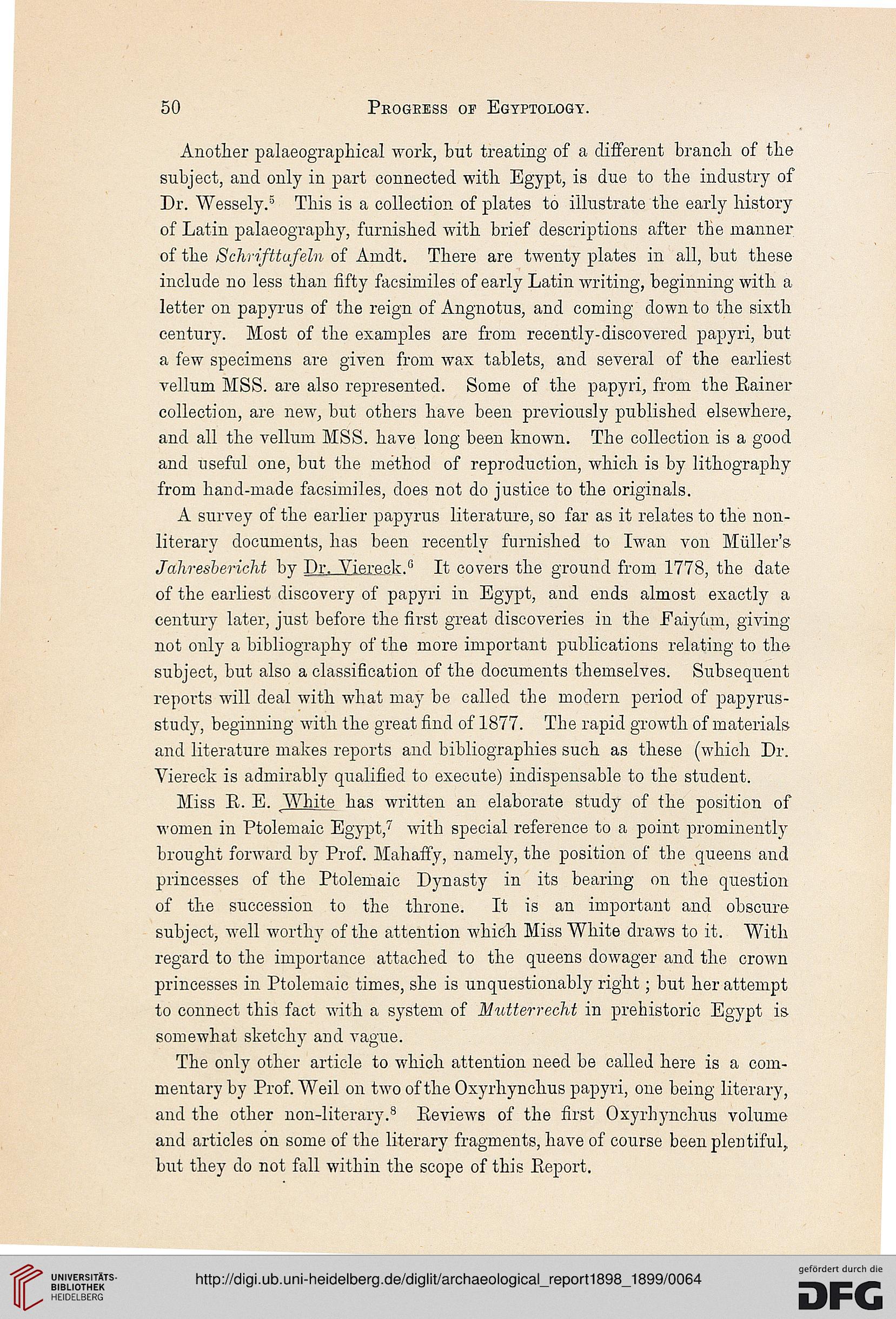50 Progkess op Egyptology.
Another palaeographical work, but treating of a different branch of the
subject, and only in part connected with Egypt, is due to the industry of
Dr. Wessely.5 This is a collection of plates to illustrate the early history
of Latin palaeography, furnished with brief descriptions after the manner
of the Schrifttafeln of Amdt. There are twenty plates in all, but these
include no less than fifty facsimiles of early Latin writing, beginning with a
letter on papyrus of the reign of Angnotus, and coming down to the sixth
century. Most of the examples are from recently-discovered papyri, but
a few specimens are given from wax tablets, and several of the earliest
vellum MSS. are also represented. Some of the papyri, from the Rainer
collection, are new, but others have been previously published elsewhere,
and all the vellum MSS. have long been known. The collection is a good
and useful one, but the method of reproduction, which is by lithography
from hand-made facsimiles, does not do justice to the originals.
A survey of the earlier papyrus literature, so far as it relates to the non-
literary documents, has been recently furnished to Iwan von Miiller's
Jahresbericht by Dr. Viereck.0 It covers the ground from 1778, the date
of the earliest discovery of papyri in Egypt, and ends almost exactly a
century later, just before the first great discoveries in the Faiyum, giving
not only a bibliography of the more important publications relating to the
subject, but also a classification of the documents themselves. Subsequent
reports will deal with what may be called the modern period of papyrus-
study, beginning with the great find of 1877. The rapid growth of materials
and literature makes reports and bibliographies such as these (which Dr.
Viereck is admirably qualified to execute) indispensable to the student.
Miss R. E. White has written an elaborate study of the position of
women in Ptolemaic Egypt,7 with special reference to a point prominently
brought forward by Prof. Mahaffy, namely, the position of the queens and
princesses of the Ptolemaic Dynasty in its bearing on the question
of the succession to the throne. It is an important and obscure
subject, well worthy of the attention which Miss White draws to it. With
regard to the importance attached to the queens dowager and the crown
princesses in Ptolemaic times, she is unquestionably right; but her attempt
to connect this fact with a system of Mutterrecht in prehistoric Egypt is
somewhat sketchy and vague.
The only other article to which attention need be called here is a com-
mentary by Prof. Weil on two of the Oxyrhynchus papyri, one being literary,
and the other non-literary.8 Reviews of the first Oxyrhynchus volume
and articles on some of the literary fragments, have of course been plentiful,
but they do not fall within the scope of this Report.
Another palaeographical work, but treating of a different branch of the
subject, and only in part connected with Egypt, is due to the industry of
Dr. Wessely.5 This is a collection of plates to illustrate the early history
of Latin palaeography, furnished with brief descriptions after the manner
of the Schrifttafeln of Amdt. There are twenty plates in all, but these
include no less than fifty facsimiles of early Latin writing, beginning with a
letter on papyrus of the reign of Angnotus, and coming down to the sixth
century. Most of the examples are from recently-discovered papyri, but
a few specimens are given from wax tablets, and several of the earliest
vellum MSS. are also represented. Some of the papyri, from the Rainer
collection, are new, but others have been previously published elsewhere,
and all the vellum MSS. have long been known. The collection is a good
and useful one, but the method of reproduction, which is by lithography
from hand-made facsimiles, does not do justice to the originals.
A survey of the earlier papyrus literature, so far as it relates to the non-
literary documents, has been recently furnished to Iwan von Miiller's
Jahresbericht by Dr. Viereck.0 It covers the ground from 1778, the date
of the earliest discovery of papyri in Egypt, and ends almost exactly a
century later, just before the first great discoveries in the Faiyum, giving
not only a bibliography of the more important publications relating to the
subject, but also a classification of the documents themselves. Subsequent
reports will deal with what may be called the modern period of papyrus-
study, beginning with the great find of 1877. The rapid growth of materials
and literature makes reports and bibliographies such as these (which Dr.
Viereck is admirably qualified to execute) indispensable to the student.
Miss R. E. White has written an elaborate study of the position of
women in Ptolemaic Egypt,7 with special reference to a point prominently
brought forward by Prof. Mahaffy, namely, the position of the queens and
princesses of the Ptolemaic Dynasty in its bearing on the question
of the succession to the throne. It is an important and obscure
subject, well worthy of the attention which Miss White draws to it. With
regard to the importance attached to the queens dowager and the crown
princesses in Ptolemaic times, she is unquestionably right; but her attempt
to connect this fact with a system of Mutterrecht in prehistoric Egypt is
somewhat sketchy and vague.
The only other article to which attention need be called here is a com-
mentary by Prof. Weil on two of the Oxyrhynchus papyri, one being literary,
and the other non-literary.8 Reviews of the first Oxyrhynchus volume
and articles on some of the literary fragments, have of course been plentiful,
but they do not fall within the scope of this Report.





